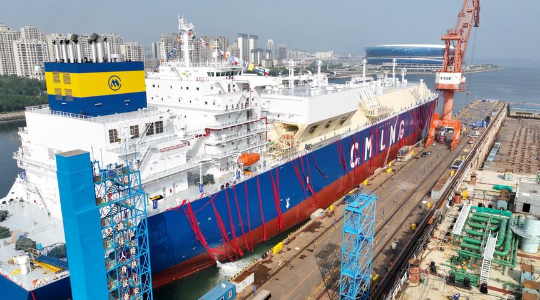China's green shipbuilding drive boosts global maritime decarbonization

An aerial drone photo taken on Sept. 24, 2025 shows the SEA SPIRIT large liquefied natural gas (LNG) carrier at a dock of Dalian Shipbuilding Industry Co., Ltd. in Dalian, northeast China's Liaoning Province. (The Dalian Shipbuilding Industry Co., Ltd./Handout via Xinhua)
At a recent green ship development conference in Dalian, a coastal city in northeast China's Liaoning Province and a key shipbuilding hub, Hengli Heavy Industry Group Co., Ltd. showcased its advancements in low-carbon vessel technology, drawing attention from European and Asian shipowners.
"As a shipowner company, we see the tremendous achievements Hengli has made in green transformation," said a general manager of Norwegian Frontline Tankers, which has six oil tankers on order at Hengli.
Hengli, established only three years ago, has built a comprehensive green industrial chain ranging from core components to entire vessel manufacturing -- and is capable of producing dual-fuel ships powered by liquefied natural gas (LNG), methanol, ammonia and other options.
In the global push to combat climate change, the shipping industry, which is responsible for most of the world trade volume, faces mounting pressure to slash its carbon footprint. The International Maritime Organization (IMO) solidified this urgency in April 2025 by mandating its net-zero framework -- targeting carbon neutrality for international shipping by 2050.
Against this backdrop, China's shipbuilding sector is emerging as a pivotal force, leveraging both innovation and scale to accelerate the transition toward green vessels.
In June this year, the world's first vessel powered by pure ammonia-fueled engine successfully debuted in east China's Anhui Province, while September saw the launch of the world's largest all-electric intelligent container ship in Jiangxi Province, also in east China, featuring swappable battery systems.
These breakthroughs highlight this sector's embrace of new energy technologies, as noted in a report issued by the Ministry of Transport, which revealed that China's fleet of new energy and clean energy ships had exceeded 1,000 vessels by 2024.
Beyond propulsion systems, China is also optimizing vessel efficiency through aerodynamic designs. For instance, the Maria Cristina delivered by Dalian Shipbuilding, a subsidiary of China State Shipbuilding Corporation, to Mediterranean Shipping Company in 2024, achieved an Energy Efficiency Design Index (EEDI) 65.5 percent below the baseline.
Policy support has been instrumental in achieving such progress. In late 2023, China issued a shipbuilding industry green development action outline (2024-2030), aiming to establish a green development system for the sector.
Relevant infrastructure development is also accelerating in China. Major ports like Dalian are positioning themselves as green fuel bunkering hubs. "Relying on strong demand for green marine fuels, Liaoning Port Group is speeding up the construction of storage, transfer and refueling centers," said Li Guofeng, CEO of Liaoning Port Group, which operates Dalian Port. He projected an annual green methanol handling capacity of 4 million tonnes within three years.
Global shipowners, notably, are voting with their orders -- in 2024, China had secured 78.5 percent of total international orders for green-powered vessels.
Chen Jianhua, president of Hengli Group, noted that 42 new ship contracts were signed in just half a month -- including 30 very large crude carriers, with orders backlogged until 2029.
Editor:伏娅敏
